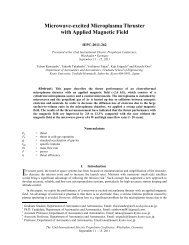Development of a Magnesium and Zinc Hall-effect Thruster
Development of a Magnesium and Zinc Hall-effect Thruster
Development of a Magnesium and Zinc Hall-effect Thruster
Create successful ePaper yourself
Turn your PDF publications into a flip-book with our unique Google optimized e-Paper software.
pumping systems, whereas operating a thruster using a metal propellant only requires a pumping system that is<br />
capable <strong>of</strong> keeping up with the cathode mass flow (assuming the cathode is operated using an inert gas).<br />
In the method used by Massey et al 1 to operate a bismuth <strong>Hall</strong> thruster, bismuth was stored in a hollow anode<br />
that served as a reservoir within the thruster discharge channel. The anode had a porous vapor diffuser that kept the<br />
heated liquid bismuth reservoir inside the hollow anode. Naturally occurring waste heat from the thruster discharge<br />
was used to drive direct evaporation from the anode/reservoir into the discharge channel where the bismuth vapor<br />
could be ionized <strong>and</strong> accelerated away from the anode. The evaporation rate <strong>of</strong> the bismuth is governed by the<br />
reservoir temperature <strong>and</strong> the vapor escape area. Since it was not feasible to mechanically vary the vapor escape<br />
area through the reservoir, the mass flow rate was to be controlled by varying the reservoir temperature within the<br />
thruster. The evaporation rate, then, is governed by the vapor pressure <strong>of</strong> the liquid metal <strong>and</strong> the goal was to<br />
maintain the proper reservoir temperature that, when combined with the vapor escape area, yielded the correct value<br />
<strong>of</strong> mass flow. 2<br />
The concept employed by Massey et al used a segmented anode design to achieve closed-loop control <strong>of</strong> the<br />
bismuth reservoir temperature. The thermal control mechanism employed three separate anodes – the traditional<br />
main anode in the back <strong>of</strong> the discharge channel <strong>and</strong> two “shim” anodes that are electrically <strong>and</strong> thermally isolated<br />
from the main anode near the exit plane. Fig. 1 shows a cut-away view <strong>of</strong> the anode locations.<br />
Outer<br />
Shim<br />
Anode<br />
Inner<br />
Shim<br />
Anode<br />
Main<br />
Anode<br />
Fig. 1. Cut-away view <strong>of</strong> a modified BPT-2000 <strong>Hall</strong>-<strong>effect</strong> thruster, showing the location <strong>of</strong> the shim anodes<br />
<strong>and</strong> main anode. The cavity within the main anode is filled with metal propellant feedstock, with the porous<br />
face allowing metal vapors to diffuse into the discharge chamber. 1<br />
The main anode served three purposes – as a propellant diffuser, as an acceleration electrode, <strong>and</strong> as a reservoir<br />
<strong>of</strong> liquid bismuth. Electron current from the discharge plasma that naturally attaches to the anode was then used to<br />
heat the anode/reservoir at a rate <strong>of</strong> approximately 10% <strong>of</strong> the total thruster power, driving the direct evaporation <strong>of</strong><br />
propellant into the chamber. Main anode temperature could then be controlled by sharing the plasma discharge<br />
current with the shim anodes on the inner <strong>and</strong> outer wall. By varying the shim voltage with respect to the main<br />
anode, the plasma current <strong>and</strong>, hence, the thermal load could be shared between the shims <strong>and</strong> main anode, thus<br />
controlling the main anode temperature <strong>and</strong> the evaporation rate. 2<br />
Unfortunately bismuth thruster development posed numerous problems that require technical advancements in<br />
material properties in order to have dependable thruster operation. Because <strong>of</strong> these problems bismuth thruster<br />
operation was limited to numerous tests <strong>of</strong> approximately 10-30 minutes duration. During these short tests the shim<br />
anode concept for propellant flow control was never conclusively demonstrated. However, the principle <strong>of</strong> using the<br />
shim/main anode scheme to control main anode temperature was proven in separate tests using xenon as propellant<br />
so that the mass flow rate could be controlled independently <strong>of</strong> anode temperature. Kieckhafer recorded plume<br />
diagnostics <strong>and</strong> thrust measurements <strong>of</strong> a BPT-2000 thruster modified to contain separate shim <strong>and</strong> main anodes <strong>and</strong><br />
The 31 st 2<br />
International Electric Propulsion Conference, University <strong>of</strong> Michigan, USA<br />
September 20 – 24, 2009






